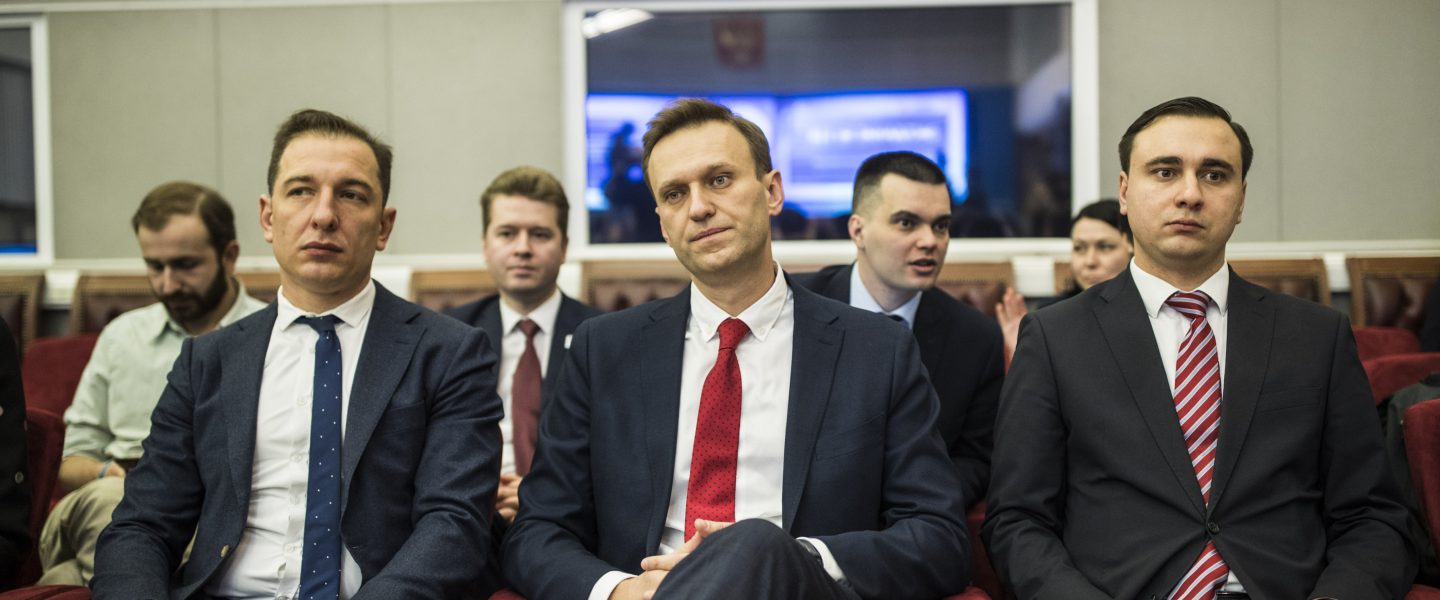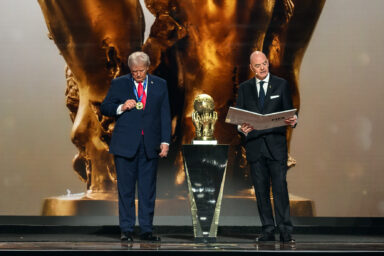Speaking out against Vladimir Putin can lead to a hospital visit … or an early grave.
|
Listen To This Story
|
After Russia’s most outspoken opposition leader, Alexey Navalny, screamed with pain on a plane flight and slipped into a coma, pro-Kremlin media were quick to discover the cause. It was all Navalny’s fault — for drinking too much moonshine in a Siberian village, requiring a morning-after hangover pill.
That, at least, was the explanation from officials in the southern Siberian city of Omsk, where Navalny was hospitalized. They insisted that only “alcohol and caffeine” were found in his urine, and that the 44-year-old lawyer turned anti-corruption crusader fell ill because of a “disrupted metabolism” and low blood sugar. In short, he couldn’t hold his liquor.
But Navalny’s personal physician had a more persuasive explanation: a poisoned cup of black tea, consumed at the airport before his flight. “It was a poisoning that led to a heavy disruption of metabolism,” Dr. Anastasia Vasilyeva told WhoWhatWhy.
Related: Rogue Russian Law Enforcement Mass-Produces ‘State Enemies’
Despite objections from the health clinic where Navalny was treated, supporters quickly arranged for a medical evacuation to Germany by air. At last report, he remained in an induced coma, but doctors expect him to survive. On Wednesday, the German government said tests by a military laboratory had shown proof of “a chemical nerve agent from the Novichok group.”
Germany’s foreign minister, Heiko Maas, said Russia must investigate the poisoning. “We condemn this attack in the strongest terms,” Maas told reporters, adding that Germany would consult with European and NATO partners “on an appropriate joint response.”
A government-ordered poisoning of an outspoken critic might sound like a chapter from an overheated political thriller. But in Russia, such incidents have been reported — and documented by overseas health experts — many times before. In some countries, foes of dissidents wield poison pens; the Kremlin prefers the equivalent of poison swords.
Putin’s Order?
Gennady Gudkov, an exiled opposition leader and former lawmaker who served in the Soviet KGB and its Russian successor, the FSB, told WhoWhatWhy that he strongly believes the poisoning was ordered by President Vladimir Putin.
“If it went against Putin’s will or sanctions, why didn’t he fire anyone, why didn’t he order an investigation to find and punish the culprits?” asked Gudkov, who was ousted from the State Duma, Russia’s lower house of parliament, for supporting Navalny. “That’s how he would have restored the trust of the international community,” said Gudkov. “Putin personally approved and sanctioned the poisoning.”
10 Years After Russian Journalist’s Murder, Reporters Everywhere Under Threat
Attacks on dissidents followed by quick denials from the Kremlin once resembled fresh, lively TV crime dramas. But now they’re more like tired reruns — same plot, different characters, though still drawing high ratings when the episodes reach Western television sets.
Since Putin’s ascension to power in 2000, almost a dozen Russian opposition leaders, turncoat intelligence officers, investigative reporters, and even a Ukrainian presidential candidate have fallen ill or died because of mysterious or sophisticated poison attacks.
The most famous case involved Alexander Litvinenko, an intelligence officer who fled to Britain and accused the Russian government of staging a series of 1999 apartment bombings — blamed on Chechen separatists — that helped elevate Putin to the presidency. Litvinenko also accused Putin of ordering the death of investigative journalist Anna Politkovskaya, who survived a suspected poison attack in 2004, but was gunned down on Putin’s birthday on October 7, 2006.
Less than a month later, Litvinenko suddenly fell ill. British doctors determined he was poisoned by radioactive polonium-210, a rare and highly toxic element. Hospitalized November 3, Litvinenko died in agony three weeks later, but his defiant claim that Putin was responsible drew worldwide attention.
The high-profile poisonings — suspected or proven — had several common threads.
In neighboring Ukraine, pro-Western presidential candidate Viktor Yushchenko became seriously ill in late 2004, and was flown to Austria for treatment. Toxicologists from three countries said he had been poisoned with dioxin, better known as Agent Orange. Yushchenko survived, though the attack left his face disfigured, went on to lead Ukraine’s Orange Revolution, and won a runoff election.
The high-profile poisonings — suspected or proven — had several common threads. They all targeted a Putin critic, were quickly denied by the Kremlin, and provoked an immediate squall of coverage on pro-government media that provided alternative explanations (Siberian moonshine in Navalny’s case), and produced token or nonexistent investigations, at least inside Russia.
After Litvinenko’s death, Russia rejected Britain’s request to extradite his suspected killer (who went on to become a nationalist lawmaker) and suggested the case was a Western conspiracy to smear Putin by engineering a spectacular murder of a Russian dissident abroad. In Yushchenko’s case, the Kremlin refused to extradite a suspect to Ukraine, and accused the victim of “self-promotion.”
More recently, Pyotr Verzilov, performance artist, producer of feminist punk band Pussy Riot, and head of a media outlet that covers atrocities in Russian prisons, said he spent “12 days in a black hole” after being poisoned with a mysterious toxin in 2018.
He was flown to the Charité hospital in Berlin, where doctors concluded that poisoning was “highly possible.” Verzilov claimed the poisoning was ordered by the GRU, or the Main Intelligence Directorate, Russia’s foreign military intelligence agency.
“The poisoning was carried out so professionally, that there could be no other conclusion,” Verzilov told Germany’s Bild magazine. Russian media accused him of being a junkie who simply overdosed.
Another Novichok?
Familiar themes — an airline flight, a suspected poisoning, a medical cover-up — emerged in the newest case. After Navalny’s plane made an emergency landing, he was rushed to a hospital in Omsk. Later, a chartered plane arrived to transport him to Berlin’s Charité hospital, where Pussy Riot’s Verzilov had been treated.
But Omsk health officials asserted Navalny was “unstable” and “unfit for transportation.” Navalny’s wife Yulia claimed they were trying to delay the flight until the traces of poison left his body.
Meanwhile, pro-Kremlin media began a smear campaign.
The Moskovsky Komsomolets tabloid cited “sources” who insisted Navalny “tried moonshine with friends” in a village outside the Siberian city of Tomsk but provided no further details.
Komsomolskaya Pravda, another tabloid known for skin photos and racist op-eds, claimed that the moonshine drinking lasted “until 2 AM,” but cited Alexander Solukov, an obscure “political analyst,” as its only source.
The plane sent to rescue Navalny stayed in Omsk for more than 24 hours before he was allowed to leave.
“Perhaps, he gulped a couple of glasses of moonshine, but we don’t know anything about its quality,” Solukov was quoted as saying. “He’s not in the headlines any more, nobody is interested in him. That’s why Navalny may have taken antidepressants, and together with low-quality village moonshine they could have led to such a reaction,” such as becoming ill or falling into a coma.
The plane sent to rescue Navalny stayed on the ground in Omsk for more than 24 hours before he was allowed to leave. After finally reaching Germany, Navalny was diagnosed with poisoning from “a substance from the group of cholinesterase inhibitors” that affects interactions between neurons, the Charité clinic said.
“While his condition is serious, it is not currently life-threatening,” the hospital reported, adding that more tests were needed to confirm the exact poison.
Cholinesterase inhibitors are used in pesticides, chemical weapons, and medications for patients with Alzheimer’s disease and other forms of dementia. Among them is a class of chemical agents that includes Novichok, a lethal toxin used in a brazen attempt in 2018 to assassinate former Russian spy Sergei Skripal in Salisbury, England.
Observers said the same sophisticated poison may also have been administered to Navalny, and was likely developed by the GRU.
“The poison of such level belongs to the GRU [department] that specializes in Novichok,” researcher Nikolay Mitrokhin of Germany’s Bremen University told WhoWhatWhy. That showed, he said, that Navalny’s attempted assassination was ordered by “either Putin or [Defense Minister Sergei] Shoigu.”
Navalny cut his teeth in politics by releasing dozens of well-researched exposés detailing corruption in the Kremlin and coined “the party of crooks and thieves” to describe United Russia, the country’s ruling party.
He targeted Putin’s closest allies, including former president and current Prime Minister Dmitry Medvedev, with reports and videos documenting their exorbitantly expensive real estate in Russia, Western Europe, and the US. A 50-minute video about Medvedev was viewed more than 35 million times and triggered massive protest rallies in 2017.
Despite his vigorous opposition to Putin’s regime, Navalny is hardly a flawless poster child for democracy. Earlier in his career, he openly espoused ultra-nationalist views and addressed thousands of far-right nationalists, white supremacists, and neo-Nazis during annual rallies known as “Russian Marches” in 2006 and 2008. In a 2007 video he compared Muslim migrants to “cockroaches” and recommended to “use a pistol” against the “invaders.”
One expert believes that one of Putin’s allies, not the Russian president himself, ordered the assassination attempt. Navalny’s team scrupulously documented the assets of dozens of oligarchs and top officials, who understand that if Putin’s regime collapses, they will lose their assets in Russia and will most probably face criminal charges.
“These people understand very well that in case of losing power they don’t just risk their wealth,” Pavel Luzin, a Russia-based analyst with the Jamestown Foundation, a Washington think tank, told WhoWhatWhy. “They are driven by fear, and that is why they are ready to kill.”
Related front page panorama photo credit: Adapted by WhoWhatWhy from russell davies / Flickr (CC BY-NC 2.0) and Pikrepo.




